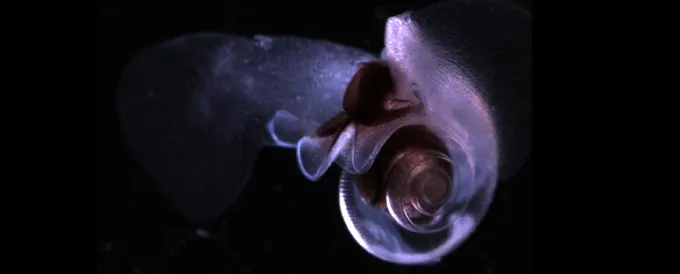
Photo by Russ Hopcroft/NOAA: A pelagic pteropod, species probably Limacina helicina.
Stanford Engineering - May 24th, 2016 - by Glen Martin
A panel of marine scientists co-chaired by a Stanford engineer has called for policy changes to counter two observable and worrisome effects of climate change – the increasing acidification of the oceans and a drop in dissolved oxygen in coastal waters.
The study group, comprising experts from the West Coast of North America including Washington, Oregon, California, and British Columbia, recently looked for ways to remediate these intertwined trends of ocean acidification and hypoxia (OAH) that result largely from human activity.
Alexandria Boehm, a Stanford professor of civil and environmental engineering, co-chaired the West Coast Ocean Acidification and Hypoxia Science Panel, which released its findings last month.
The report seeks to address an increasingly dire situation. As the concentration of CO2 in the atmosphere rises, the oceans tend to absorb more carbon, some of which reacts with water to form carbonic acid. Close to shore this process is exacerbated by an interaction with algal blooms – growths of marine life that are stimulated by nutrient-laden runoff from farms and cities. When the algae die and sink, bacteria consume the remains, releasing even more CO2 into the ambient water. The elevated CO2 levels result in hypoxia, a reduced level of oxygen dissolved in the water with deleterious effects on marine life.
The impacts of ocean acidification and hypoxia, however, are not distributed evenly across the world’s oceans. “The effects of acidification and hypoxia are magnified on the West Coast due to upwelling,” Boehm says. “Upwelling occurs when wind moves surface water away from the coast, allowing deeper water to rise up. This deeper water typically is lower in pH and dissolved oxygen, compounding the acidification problem.”
Until recently, most research has been devoted to documenting the twin phenomena and determining the likely – and exceedingly grim – outcomes. The West Coast study panel has taken this science to the next step by suggesting policy-driven responses to some of the impacts.
Recommendations include:
- Taking steps to reduce onshore pollutants that contribute to algal blooms and hypoxia;
- Developing ecologically based approaches to removing CO2 from water, such as planting seagrass;
- Reducing concurrent “stressors” on marine life such as overfishing, habitat destruction and invasive species; and
- Identifying techniques that could enhance the capacity of marine creatures to adapt to more acidic environments.
George Somero, a Stanford professor emeritus of marine science and an executive committee member of the panel, says OAH already is hurting both marine life and local economies. The impacts are most immediately apparent on any animal that builds calcareous shells, including oysters, snails and free-floating, minute creatures known as pteropods.
“Pteropod shells are being severely damaged by increasing ocean acidity,” says Somero, “and that’s perhaps one of the most striking ways of presenting this issue. You can’t feel acidity and low oxygen in the water, but when you see a photograph of these deeply etched shells, it makes the magnitude of the problem clear. We always hear about the significance of krill to food fish such as salmon and pollock, but pteropods can be even more important. If you take out pteropods, you’re really pulling the rug out from under the marine food web.”
Increased acidity also has been identified with failures in West Coast oyster operations. A few years ago in Netarts Bay, Oregon, producers discovered that larval oysters were not developing shells. “The growers thought it might be disease or chemicals, and then they ultimately determined it was due to acidified water,” says Boehm.
Such developments have ominous implications for the entire marine environment, says Francis Chan, an associate professor of integrative biology at Oregon State University and a co-chair of the panel. “When you look at the issues associated with climate change, it can be pretty scary,” Chan says. The good news with our report is that we’ve identified policies that could mitigate some of the impacts.”
In the case of Netarts Bay, Chan continues, an effective response already has been found. “Netarts Bay is shallow and lush with sea grass,” says Chan. “During the day, the grasses are photosynthesizing, which requires them to metabolize lots of CO2 and give off oxygen, raising the pH of the water. But the oyster farm was often pumping the water they need for their operations at night, when photosynthesis had stopped and the water was more acidic. So now they pump their water at the end of sunny days, after an extended period of photosynthesis. That has pretty much resolved their problem.”
The Netarts Bay experience informs one of the panel’s recommendations, says Boehm: the establishment of pilot projects that could lead to the expansion of sea grass and eel grass habitats in West Coast estuaries. “This could have benefits other than addressing OAH,” says Boehm. “Sea grass and eel grass flats are valuable foraging areas and nurseries for a wide variety of marine organisms. Their expansion could help increase biodiversity and ecosystem resilience in estuaries and nearshore waters.”
The report also recommends overhauling existing water quality criteria. “When the Clean Water Act was passed the pH standards were tailored for acidic discharges from industrial plants, and did not address ocean acidification caused by climate change,” says Boehm. “We need new thresholds that establish pH limits tolerable to marine life.”
In some cases, Chan notes, OAH goals can be dovetailed with existing programs. A “molluscan rootstock” initiative in Oregon currently focuses on breeding oysters that achieve marketable size in as short a time as possible. But now managers are looking at developing strains that are relatively resistant to low pH. “Another exciting possibility involves the series of marine protected areas California has established in recent years,” Chan says. “Originally, they were designed to protect marine biodiversity. But they could also protect animals that show genetic resistance to acidification.”
The report already is generating waves in the legislative sphere. “Two bills are moving through Sacramento that refer directly to the panel’s actions,” says Boehm. “One addresses sea grass expansion and the other involves revising water quality criteria. We’re hopeful that’s just the start. We really see this effort as an inflection point. The panel was composed entirely of scientists, but we conducted our work with policymakers in mind. We felt compelled to recommend responses that could make a real difference.”
The panel’s findings may be viewed at: http://westcoastoah.org/


